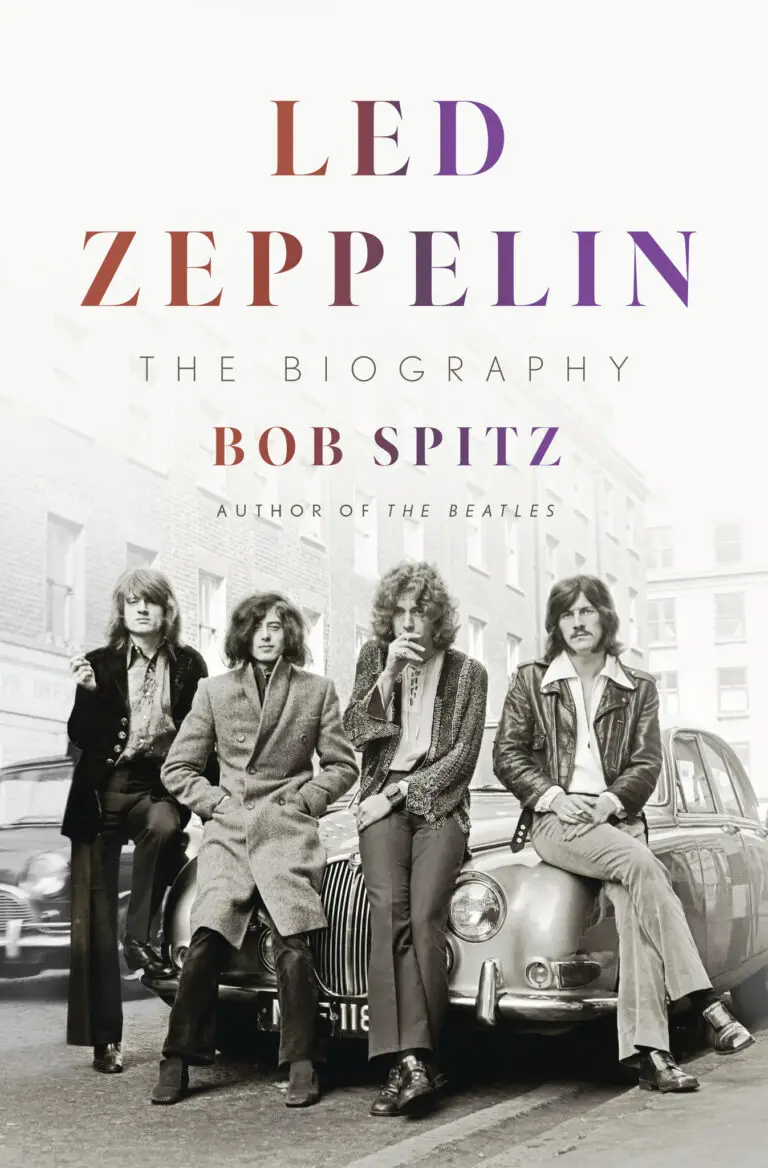In 2005, music manager turned biographer Bob Spitz fashioned 1,000 pages to craft the definitive biography of The Beatles, the music- and culture-quaking foursome who reshaped the Sixties. Now, Spitz has put his superior skills as a researcher, storyteller and music industry analyst to work creating another definitive, doorstopper-sized music biog. This one is dedicated to the Brit foursome who, like The Beatles before them, ruled supreme in their decade, 1970s mighty Led Zeppelin. This was a group that not only revolutionized how rock music was recorded and performed. They also rewrote the rules about how stars could wield their fame to new levels of drug- and sex-addled offstage excess, a brand of heavy metal debauchery that would never fly in today’s “me-too” era.

Just like his best-selling biographies of The Beatles, Bruce Springsteen and Bob Dylan, Led Zeppelin: The Biography (Penguin Press) unearths mountains of fresh facts and stories missed in the multitude of books that came before it. Spitz also rights many erroneous facts and legends about the secretive and somewhat paranoid Zep, ones that have been carried along for decades by lazy rock journos and, in many cases, the band itself.
Spitz conducted 150 interviews with Zep’s fellow music makers, record execs, concert promoters, longtime friends and groupies to put together this nearly 700-page epic. They share eyewitness accounts of the band’s legendary exploits – everything from who really stole the money at the infamous Drake Hotel robbery to the step-by-step creation of their masterful albums and songs, more than a few initially “lifted” – sans credit and cash compensation – from the American blues artists they claimed to idolize.

Any book about Zeppelin must start with Jimmy Page, the band’s founder, guitar god, groundbreaking producer and magician – literal and figurative.
With Page, Spitz goes back to the beginning. He commences by sharing how Pagey got his started in his guitar journey by devouring a copy of Bert Weedon’s Play in a Day instructional book, his appearance as a 13-year-old playing skiffle on a BBC-TV children’s show and his teenage apprenticeship in a multitude of early bands, one under the stage name “Nelson Storm.” Spitz also clarifies some of the facts about Page’s illustrious pre-Zeppelin career as a session guitarist. This is a guy who was featured on smash hits like Petula Clarke’s “Downtown,” Marianne Faithfull’s “As Tears Go By,” Tom Jones’ “It’s Not Usual,” the theme from the James Bond film Goldfinger and his rhythm guitar (not lead as is sometimes stated) on The Kinks’ “You Really Got Me” and The Who’s “I Can’t Explain.” Something I had never heard before was of his dalliance in something he dubbed “rocketry” – playing solo guitar behind the Beat verse of poet Royston Ellis. Also referenced in his early experience producing four definitive tracks with Brit blues godhead John Mayall and Eric Clapton. Also noteworthy is his discovery, at age 11, of pagan mystic Aleister Crowley and his book Magick in Theory and Practice, something that will figure largely in Zeppelin’s music and Page’s hedonist lifestyle.
The road to Zeppelin was set when Page tired of studio work and joined The Yardbirds, first to play bass behind his childhood friend Jeff Beck’s lead guitar. Page ultimately joined Beck on dual leads for a short, sensational time, until Beck departed and Page essentially assumed musical leadership of a band that was on its last legs. At this point, Zep manager-to-be Peter Grant enters the picture. Spitz paints a detailed portrait of the 300-plus-pound Grant’s road to Zep’s mega-manager. This includes his stints as a professional wrestler known as “His Royal Highness Count Bruno Alessio of Milan,” as a debt enforcer for notorious Soho gangs to, finally, his earliest management experiences with an unsuccessful band called The Flintstones and The New Vaudeville Band, a 1920s parody act that scored a global novelty hit with “Winchester Cathedral.”
It is with Grant’s invaluable support and muscle that Page makes his move to create the unique blues- and folk-powered band he had long envisioned, with veteran studio multi-instrumentalist and arranger John Paul Jones and two Northern newcomers to the big time, in singer Robert Plant and earthshaking drummer John “Bonzo” Bonham. Spitz’s wordsmithery literally puts you in the room as the foursome get together for the first time on a sweltering day in August 1968 to jam. It creates a moment of such brilliances and power that they all break down into laughter after the first number.
Spitz follows the halcyon days of the band, from their contractually obligated debut on a Scandinavian tour as “The New Yardbirds” to their breakup after the death of drummer John Bonham in September 1980. The book will delight musicians who will hear the stories of the writing of classics like “Stairway to Heaven” and “Kashmir,” how they used the studio to conjur magical sounds like the thunderous drums on “Moby Dick” and the skinny on all their controversial “appropriation” of riffs and words from bluesmen like Willie Dixon and Howlin’ Wolf on tunes like “Whole Lotta Love” and “The Lemon Song.”
What is sometimes lost to the mists of time is their huge unpopularity and subsequent war with the press, especially the critics at Rolling Stone Magazine. Right out of the box, their debut album was criticized as a pale imitation of Jeff Beck’s Truth and the criticisms just grew with each platinum album and sold-out tour. After several years declining every request for interview, the band enlisted a heavyweight PR agency to tackle the matter with limited success. A Hollywood press event meant to draw a bevy of celebs only drew Lloyd Bridges, father of actor Jeff, perhaps best known for his stint as an aqualung wearing detective in the late 1950s TV series, Sea Hunt. In another star-studded moment, the band engages in a food fight with none other than TV’s Kojack, actor Telly Savalas! The A-list was off on tour with the Rolling Stones, whose press coverage infuriated the maybe even more successful Zeppelin.
Any book about Led Zeppelin would be sinfully incomplete without a deep dive into their depravity on the road. Here, the Marquis de Sade/whips & chains lovin’ Page and booze-soaked Bonzo are the stars.
The author clarifies some points about Page’s infamous relationship with “baby groupie” Lori Mattix, who was his LA lady for a few years between his stateside romantic dalliances with Pamela Des Barres and Bebe Buell. Mattix became Page’s main squeeze for his tours in the U.S. at age 15, but not before losing her virginity to David Bowie at 12, according to the book. Bonzo’s exploits are even more gruesome and Spitz recounts a cornucopia of golden hits of depravity. These include the famous Mudshark episode while on tour with Vanilla Fudge immortalized in song by Frank Zappa, his trying to coax a Great Dane into having sex with a groupie at the Chateau Marmont, his doing a #2 in the purse of Page’s Japanese girlfriend and monumental consumption of drink and cocaine which often spurred his to sudden acts of violence. The latter was an addiction shared by all the band and its manager. In one morbidly humorous episode, Grant is so coked up that he mistakes a TV remote for a sandwich and breaks a tooth. In another, fountain pen ink leaks into their stash, but they sniff it nonetheless and gain blue nostrils which they proudly carry for a few days. By their 1977 tour, the wheels are coming off the bus with Page’s serious heroin addiction. It especially infuriates Plant as Page sometimes screws up on his famed double-necked guitar, by fingering one neck and picking the other.
There is more detail on their battles with the descendants of airship inventor Count Ferdinand von Zeppelin, who at first would not let any “babbling apes” make money off her family name or by using its image on their first two albums cover art. Speaking of cover art, there’s some fun details on their various makings and controversy, including how they sprayed naked children with gold auto paint for the cover of House of the Holy. Also explored are their successes and misses with their record label, Swan Song. It’s Zeppelin we have to thank for the litany of classic rock classics by the hard rocking Bad Company. But Spitz is the first author I’ve heard to divulge their passing on the opportunity to sign both Queen and Heart.
But the heart of Spitz’s book is an exploration of both the making of the music and Led Zeppelin as the touring juggernaut, that one that brought rock from small clubs to stadiums. With 300 million albums sold, with their creativity with studio sound and song form, with their hundreds of performances over 30 global spanning tours and their colorful excesses, Led Zeppelin is a band deserving such a sprawling tome. As usual, the mighty Spitz has truly written, and perhaps closed the book forever, on the heaviest rock band of its era.


Comments are closed.